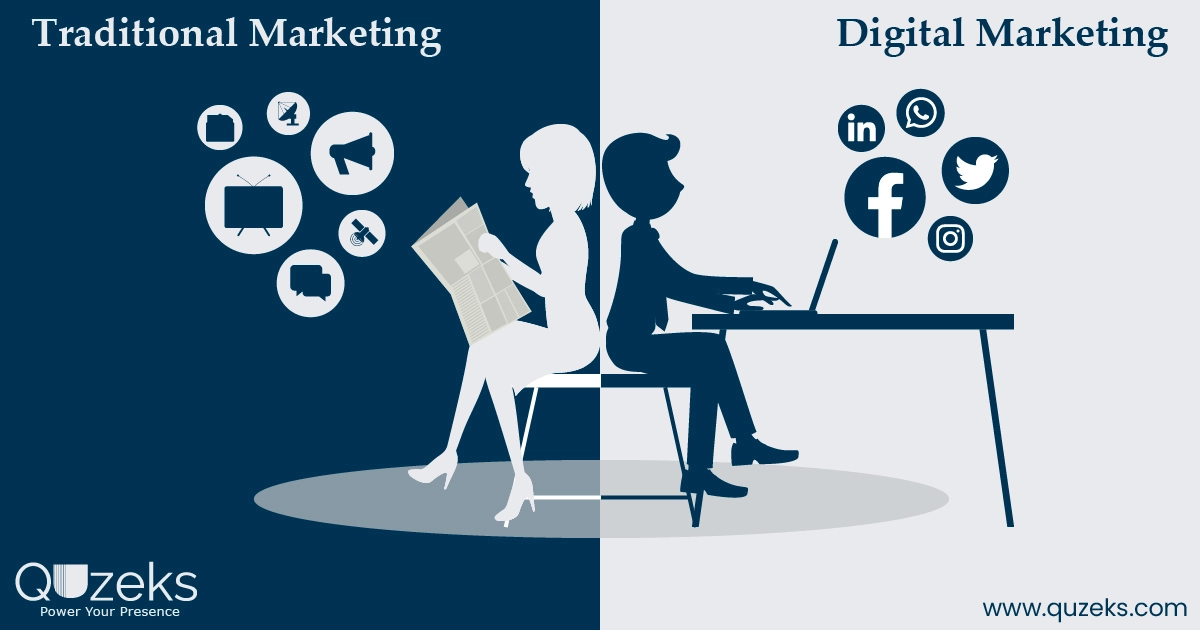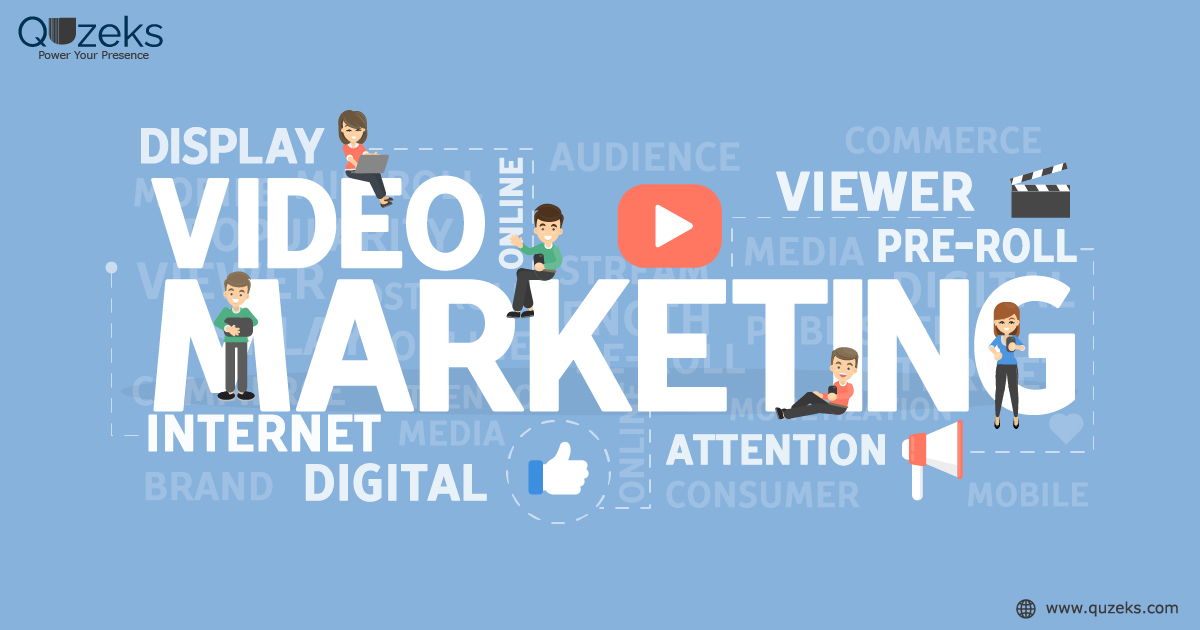- In this ever-evolving landscape, two main approaches reign supreme: traditional and digital marketing.
- Traditional marketing encompasses the tried-and-true methods we’ve all grown up with – think TV commercials, newspaper ads, and flyers handed out on the street corner.
- Meanwhile, digital marketing leverages the power of the internet and technology, with strategies spanning social media, email campaigns, and search engine optimization.
- As businesses strive to connect with their target audiences in today’s fast-paced world, meanwhile, the debate between traditional and digital marketing rages on.
- The key differences, advantages, and challenges of each approach, helping you navigate the complexities of modern marketing strategies.
Difference of Traditional vs Digital Marketing:
Here is the difference between traditional marketing vs digital marketing in simple words:
| Aspect | Traditional Marketing | Digital Marketing |
| Reach and Targeting | Reaches a broad audience through mass media channels | Allows for exact targeting based on demographics, interests, and online behaviour |
| Cost-effectiveness | Can be costly, especially for TV ads or billboards | Generally more cost-effective with flexible budgeting options |
| Measurable Results | Difficult to measure the success of campaigns | Provides real-time analytics for tracking performance metrics |
| Interactivity | Limited interaction with consumers | Fosters two-way communication and engagement with consumers |
| Flexibility | Limited flexibility in making changes to campaigns | Allows for quick adjustments and optimization of campaigns |
| Geographic Reach | Often limited to local or regional markets | Can reach a global audience with targeted advertising |
| Tangibility | Physical materials like brochures or flyers | Digital assets like websites, social media profiles, and email campaigns |
| Timing | Long lead times for production and distribution | Can launch campaigns quickly and adjust in real-time |
| Audience Engagement | Relies on inactive consumption of content | Encourages active engagement and participation from the audience |
| ROI Measurement | ROI can be challenging to quantify | Provides clear metrics for measuring return on investment |
| Scalability | Limited scalability due to physical restrictions | Offers scalability for reaching larger audiences and expanding reach |
| Personalization | Offers limited personalization in messaging | Allows for highly personalized messaging tailored to individual preferences |
| Accessibility | Limited accessibility, especially for niche markets | Provides access to a global audience regardless of geographical location |
| Interaction Speed | Communication and feedback cycles are slower | Communication and feedback cycles are faster and more immediate |
| Competitive Advantage | May provide a competitive advantage in certain industries | Offers opportunities for innovative marketing approaches and staying fast of competitors |
These aspects provide a comprehensive overview of the differences between traditional marketing and digital marketing, covering aspects such as reach, cost, measurability, interactivity, scalability, and more.
Traditional Marketing
What is Traditional Marketing?
- Traditional marketing encompasses conventional methods of promoting products or services through offline channels.
- Moreover, these methods have long been the cornerstone of marketing efforts and include:
Modes of Traditional Marketing:
Print Media: Advertising in newspapers, magazines, brochures, flyers, and direct mail.
Broadcast Media: Television and radio commercials, reaching a wide audience through mass media channels.
Outdoor Advertising: Utilizing billboards, posters, banners, signage, and vehicle wraps in public spaces.
Direct Sales: Door-to-door sales, telemarketing, and face-to-face interactions with potential customers.
Events and Sponsorships: Participating in trade shows, exhibitions, conferences, and sponsoring events or sports teams.
Advantages of Traditional Marketing:
Wide Reach: Traditional methods can reach a broad audience, including individuals who may not be active online or tech-savvy.
Tangible Presence: Physical ads in newspapers or billboards provide a tangible presence that consumers can see, touch, and remember.
Established Credibility: Traditional marketing channels, such as print publications or television networks, often carry a sense of authority and credibility.
Disadvantages of Traditional Marketing:
Limited Targeting: Traditional methods lack the precision targeting capabilities of digital marketing, making it challenging to reach specific demographics or niche audiences.
High Cost: Producing and distributing materials like TV commercials or billboards can be prohibitively expensive, especially for small businesses with limited budgets.
Harder to Measure ROI: It’s challenging to track the effectiveness of traditional campaigns accurately and measure the return on investment, leading to uncertainty about their success.
Significance of Traditional Marketing:
- Traditional marketing still holds relevance in today’s digital age, particularly for businesses targeting older demographics or operating in industries with a strong reliance on physical presence.
- Furthermore, it offers a tangible and authoritative way to reach a broad audience, complementing digital efforts and establishing brand credibility.
Digital Marketing
What is Digital Marketing?
- Digital marketing leverages online platforms and technology to connect with target audiences and promote products or services.
- It encompasses a wide range of strategies and channels, including:
Modes of Digital Marketing:
Social Media Marketing: Engaging with audiences on platforms like Facebook, Instagram, Twitter, and LinkedIn through organic content and paid advertisements.
Search Engine Optimization (SEO): Optimizing websites to rank higher in search engine results pages, increasing visibility and organic traffic.
Content Marketing: Creating and sharing valuable content, such as blog posts, videos, podcasts, info graphics, and eBooks, to attract and engage target audiences.
Email Marketing: Sending targeted emails to potential customers to nurture leads, promote products, and build relationships.
Pay-Per-Click (PPC) Advertising: Placing targeted advertisements on search engines like Google or social media platforms, paying only when users click on them.
Affiliate Marketing: Partnering with affiliates or influencers to promote products or services in exchange for a commission on sales generated.
Influencer Marketing: Collaborating with social media influencers or celebrities to endorse products or services and reach their followers.
Advantages of Digital Marketing:
Precise Targeting: It allows businesses to target specific demographics, interests, and behaviours, ensuring that their messages reach the right people at the right time.
Cost-effectiveness: Compared to traditional methods, online marketing is often more affordable, with flexible budgeting options and lower entry barriers for small businesses.
Measurable Results: Real-time analytics provide insights into campaign performance, allowing businesses to track metrics like website traffic, conversions, and engagement, and make data-driven decisions to optimize their strategies.
Global Reach: It offers access to a global audience, breaking down geographical barriers and enabling businesses to expand their reach beyond local markets.
Interactivity and Engagement: Digital channels facilitate two-way communication and engagement with audiences, allowing for real-time interaction, feedback, and relationship-building.
Disadvantages of Digital Marketing:
Saturation: With the abundance of content online, it can be challenging to stand out and capture audience attention amidst the noise.
Technical Complexity: Requires a nuanced understanding of various platforms, algorithms, and tools, making it daunting for newcomers or those without technical expertise.
Potential for Information Overload: Consumers may feel overwhelmed by the constant barrage of digital advertisements, emails, and content, leading to fatigue and disengagement.
Dependency on Technology: Online Marketing is susceptible to disruptions caused by technical issues, algorithm changes, platform outages, or cyber security threats.
Significance of Digital Marketing:
- In today’s digital-centric world, digital marketing has become indispensable for businesses of all sizes and industries.
- It offers unparalleled opportunities for targeting, engagement, and measurement, consequently enabling businesses to reach global audiences, build relationships with customers, and drive tangible results.
Which is better for Business
- In today’s digital age, digital marketing often offers more flexibility, precise targeting, and measurable results compared to traditional marketing.
- However, traditional methods still hold relevance, particularly for businesses targeting older demographics or operating in industries with a strong reliance on physical presence.
- The best approach is often a strategic blend of both traditional and digital marketing, tailored to the specific needs and objectives of the business.
- Additionally, by leveraging the strengths of each approach, businesses can maximize their marketing efforts and achieve greater success in reaching and engaging their target audience.
Conclusion:
- In the grand scheme of marketing, both traditional marketing and digital marketing play vital roles, each with its unique advantages and challenges.
- While traditional methods offer a tangible and authoritative way to reach a broad audience, digital strategies provide precision targeting, cost-effectiveness, and measurable results.
- Quzeks is the best digital marketing agency in india to grow your business sucessfully.
References:
- Marketing [1].
Traditional marketing relies on offline channels such as print ads, TV commercials, and billboards, while digital marketing utilizes online platforms like social media, websites, and email campaigns. Traditional marketing tends to have a wider reach but lacks precise targeting, while digital marketing offers better targeting and real-time analytics.
Digital marketing provides several advantages over traditional marketing, including lower costs, greater flexibility, real-time analytics, precise targeting, and the ability to engage with audiences in interactive ways. Additionally, digital marketing campaigns can be easily adjusted and optimized based on performance data, leading to higher ROI.
Yes, digital marketing is generally used more than traditional marketing due to its effectiveness, targeting capabilities, and measurable results.




